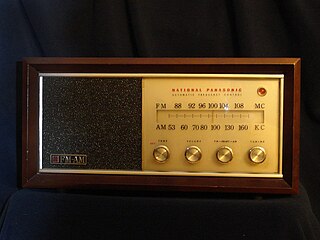 W
WThe 3DO Interactive Multiplayer, commonly referred to as 3DO, is a home video game console developed by The 3DO Company. Conceived by entrepreneur and Electronic Arts founder Trip Hawkins, the 3DO was not a console manufactured by the company itself, but a series of specifications, originally designed by Dave Needle and R. J. Mical of New Technologies Group, that could be licensed by third parties. Panasonic produced the first models in 1993, and further renditions of the hardware were released in 1994 by GoldStar, and in 1995 by Sanyo.
 W
WThe Panapet radio is a round novelty radio on a chain, first produced by Panasonic in the early 1970s to commemorate the World Expo in Osaka Two chrome plated dials on the surface are for tuning and volume, and a tuning display is inset on the surface of the ball. The Panapet is AM band only - no FM. There is a jack for a mono earplug. The Panapet came in several colors including red, yellow, white, blue, purple and avocado green.
 W
WThe Panasonic FS-A1WSX released in 1989 was the last MSX2+ made by Panasonic. It was the successor of FS-A1WX and incorporated few changes like S-Video output, no tape support, color printer support and an improved A1 Internal Cockpit software with a Kanji color word processor.
 W
WThe Jungle was a portable game console in development by Panasonic, and announced in October 2010. With a design being roughly similar to a small laptop, it was developed as a portable platform for MMOs and aimed at players who wanted to play online games on the go. The Jungle was also Panasonic's first attempt at creating a handheld console. It was expected to be released in mid-2011, effectively putting it into the eighth generation of gaming along with the Nintendo 3DS and the then-unreleased PlayStation Vita.
 W
WThe National Panasonic Model RE-784A is a vacuum tube AM/FM table radio from the post-war era (1960s) manufactured by National Panasonic. The miniature tube-based circuitry follows the "All American Five" tube design, which allowed a more compact footprint of the radio; suited for sitting atop a fireplace mantle or to be mounted under a kitchen cabinet. One feature of the FM band for this radio is AFC tuning, that allowed the listener to "lock-in" an FM station without having to worry about station drifting or drops in audio volume associated with FM station tuning.
 W
WThe Technics SL-10 is a direct-drive, linear tracking automatic turntable, which was produced from 1979 to 1985.
 W
WTechnics SL-1200 is a series of direct-drive turntables originally manufactured from October 1972 until 2010, and resumed in 2016, by Matsushita Electric under the brand name of Technics. S means "Stereo", L means "Player". Originally released as a high fidelity consumer record player, it quickly became adopted among radio and disco club disc jockeys, thanks to the direct drive, high torque motor design, making it initially suitable for pushbutton cueing and starting of tracks on radio and in dance clubs. It is still extremely popular with audiophiles.
 W
WThe Toot-a-Loop Radio or Panasonic R-72 is a novelty radio made by Panasonic Japan in the early 1970s. This radio was designed to be wrapped around the wrist. It also came with stickers for customizing the unit. Reception was the AM broadcast band only - no FM. The radio was shaped something like a donut with the hole off-center. When twisted, the smaller half would pivot and the larger half would separate, forming an "S" shape. One side of the radio had a grille behind which sat the speaker. There was also a jack for a mono earplug. The tuner was located inside one of the "splits," so the radio had to be twisted into the "S" position in order to be tuned, but the volume control was on the outer diameter of the radio and could be adjusted regardless of whether the radio was twisted open or closed. The Toot-a-Loop came in several colors including white, red, blue, and yellow. It was also produced in orange and lime, which were sold in Australia and New Zealand. Australian and New Zealand models had the badging National Panasonic and were advertised as a "Sing-O-Ring" radio. Also known by collectors as a bangle or wrist radio. The advertisement song went "It's an S it's an O it's a crazy radio! Toot a loop!".